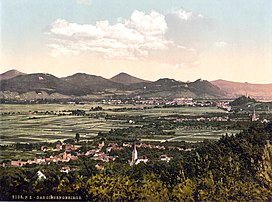Siebengebirge
This article needs additional citations for verification. (May 2015) |
| Seven Hills | |
|---|---|
 Seven Hills, 1900 | |
| Highest point | |
| Peak | Großer Ölberg |
| Elevation | 460 m (1,510 ft) |
| Naming | |
| Native name | Siebengebirge Error {{native name checker}}: parameter value is malformed (help) |
| Geography | |
Lua error in Module:Location_map at line 526: Unable to find the specified location map definition: "Module:Location map/data/Siebengebirge Übersichtskarte.png" does not exist.
| |
| Country | Germany |
| Region | North Rhine-Westphalia and Rhineland-Palatinate |
| Geology | |
| Orogeny | Volcanic |
| Age of rock | Oligocene |

Seven Hills,[1][2][3] or Seven Mountains (German: Siebengebirge), is a Central Uplandish hill range on the east bank of the Middle Rhine, southeast of Bonn, Germany. The area, located in the municipalities of Bad Honnef and Königswinter, consists of more than 40 hills. The hills are of ancient volcanic origin and came into being between 28 and 15 million years ago. Much of the territory covered by Seven Hills belongs to the Seven Hills Nature Park (Naturpark Siebengebirge), which is under environmental protection.
The highest peak is the Ölberg at 460 metres above sea level. It is a popular tourist destination for hiking, because of its natural beauty.
Hills
The seven most important hills:
- Großer Ölberg (460 m)
- Löwenburg (455 m)
- Lohrberg (435 m)
- Nonnenstromberg (335m)
- Petersberg (331 m, Former name: Stromberg)
- Wolkenburg (324 m)
- Drachenfels (321 m)
Other hills:
- Himmerich (366 m)
- Trenkeberg (430 m)
- Weilberg (297 m)
- Stenzelberg (287 m)
- Broderkonsberg (378 m)
- Mittelberg (353 m)
- Leyberg (359 m)
- Jungfernhardt (320 m)
- Geisberg (324 m)
- Schallenberg (310 m)
- Großer Breiberg (313 m)
- Kleiner Breiberg (288 m)
- Wasserfall (338 m)
- Kleiner Ölberg (332 m)
- Limperichsberg
- Scharfenberg
- Zickelburg (182 m)
Origin of the German name
This section possibly contains original research. (May 2015) |
Although the common English name "Seven Hills" is merely the most logical translation of the German name, Siebengebirge, the origins of the latter are disputed. Three theories exist:
- The oldest name (Moller, 1590) was not Siebengebirge, but Sieben Berge (septem montes, seven hills). Depending on the viewpoint near the river Rhine, one notices almost exactly seven hills, which are not always the same and not even the highest. Also, the number seven used to denote an arbitrary amount of items, was connected to magic and thus had a highly symbolic meaning. This makes it an obvious name for an area that was said to be sinister and impenetrable before the 19th century.
- The word sieben is derived from the word siefen, which denotes the wet valley of a stream.
- The name Siebengebirge emerged from the word Siedengebirge which indicated the presence of soap boilers ("Seifensieder"), who were banned from the valleys because boiling soap smelled so bad.
References
- ^ Encyclopedia Britannica, A. Constable, 1911. Retrieved 10 Feb 2015.
- ^ Seven Hills newspaper article
- ^ The Castles of the Rhine by Robert R. Taylor (2009). Retrieved 10 Feb 2015.
External links
- Information and pictures about Seven Hills
- Rhine Dragon The Seven Mountains: a virtual tour, history, old and new legends, nature
- Honnefer Bilderbogen with pictures of Seven Hills

